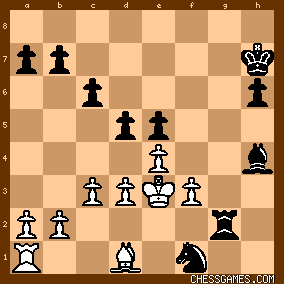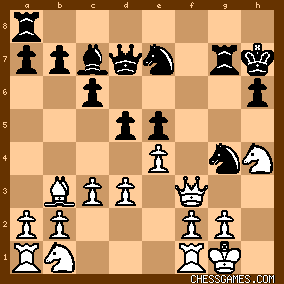|
< Earlier Kibitzing · PAGE 2 OF 2 ·
Later Kibitzing> |
| May-18-13 | | diagonalley: good puzzle, but not "very" difficult to solve |
|
| May-18-13 | | devere: A nice combination but also obvious, not difficult. If White wants to continue playing he must play 24.Qxf3. Black would have the material advantage of Queen+Knight for two Rooks plus a pawn, but it's always possible he could fail to win the "won" game. |
|
May-18-13
 | | al wazir: What if white doesn't take the ♘? 25. f4 Qh3 (25...Nxf1 26. Kxf1; 25...Rg8+ 26. Kxh2) 26. Qh5 Qxf1+ 27. Kxh2. Now what? |
|
| May-18-13 | | LJLMETAL: Nice combo. I knew the first move, because that blocks the white Queen from defending. I just couldn't figure out the correct continuation. |
|
May-18-13
 | | Dionysius1: <al wazir> Maybe 27...Rg8 |
|
May-18-13
 | | Dionysius1: Sorry- white seems to have a perpetual then. |
|
| May-18-13 | | agb2002: Black is one pawn.
White threatens 24.Ng5+ hxg5 25.Qxg4 Qg7 26.Qg3 with the idea Bg4-Bf5. The first move that comes to mind is 23... Rxf3 to further weaken the white castle, 24.gxf3 Nh2, to free the path for the queen and rook while creating threats: A) 25.Kxh2 Rf4
A.1) 26.Rh1 Rh4+ 27.Kg3 (27.Kg1(2) Qg7+ 28.Kf1 Rxh1#) 27... Rxh1 and 28... Qh3#. A.2) 26.Rg1 Rh4+ 27.Kg2(3) Qh3#.
A.3) 26.Re1 Rh4+ 27.Kg1 Qh3 (or 27... Qg7+) and mate next. A.4) 26.Kg2(3) Qg7+ 26.Kh3 Qg5 and 27... Rh4#.
A.5) 26.Qe3 Rh4+ and mate in two.
B) 25.Re1 Qh3 26.f4 Rg8+ 27.Qg4 (27.Kh1 Nf3#) 27... Nxg4+ 28.Bxg4 Rxg4#. C) 25.f4 Qh3 26.f3 (26.Qh5 Rg8+ and mate soon) 26... Rg8+ 27.Kf2 (27.Kh1 Nxf3+ 28.Qh2 Qxh2#) 27... Rg2+ 28.Ke1 Rxe2+ 29.Bxe2 Nxf1 30.Bxf1 Qxf3 - + [Q vs R]. D) 25.Kg2 Rg8+ 26.Kxh2 (26.Kh1 Qh3 and mate next) 26... Qg7 and mate in two. |
|
May-18-13
 | | PawnSac: < al wazir: What if white doesn't take the N? 25. f4 Qh3 (25...Nxf1 26. Kxf1; 25...Rg8+ 26. Kxh2) 26. Qh5 Qxf1+ 27. Kxh2. Now what?> In your line 25.f4 Qh3 26.Qh5 Qxf1+ 27.Kxh2 the simple < 27 ..Qxf2+ > is winning. ( ..Rg8 threatening Qg1+ and Qh1#, allows white to play for the repetition after Qf7+ Rg7 29. Qf5+ Kh8 30. Qf8+ Kh7) < 28. Kh3 Qxf4 > and black is much better
since the white king is dangerously exposed to attack and his development is behind. i.e., 29. Bg4 (29. exd5 Qf1+ 30. Kh2 Rf2+ 31. Kg3 Rg2+ 32. Kh3 Qh1# ) dxe4 30. dxe4 Qxe4 31. Rg1 Qd3+ 32. Rg3 Qf1+ 33. Kh2 Rf2+ |
|
May-18-13
 | | PawnSac: Though 4. ..Bd6 is not best, black did manage to get good play out of the opening. White's strategy wasted several tempi, so that black was able to get compensation for the H pawn with rapid rook development. White's 23.Bd1 seems to be the loser. Possibly better was 24.exd5 but it still appears black can get dangerous play.
The great Staunton was expertly outplayed. |
|
| May-18-13 | | anandrulez: Nice puzzle there . I found the Nh2 idea that is seen in many games but Rf4 no ! I was thinking like Rg8 might work , Queen also comes to g or h later on . |
|
| May-18-13 | | alphee: it's been a while since my last visit and for a saturday puzzle this one wan't too tough. The first 2 moves for black were easy but wasn't quite sure about ♘h2 before I saw the move on the board. Except when moves are obvious I have difficulty seing after the 3rd or 4th one so I usually give up and play, it save time on the clock and often it works. |
|
| May-18-13 | | Ratt Boy: After reading of how he avoided Morphy when the latter was visiting Europe, I'm happy to see Staunton get busted. His behavior was so unsportsmanlike that I propose a boycott of Staunton pieces. |
|
| May-18-13 | | sfm: <al wazir: What if white doesn't take the N? 25. f4 Qh3 [...] 26. Qh5 ...> The blunt 26.-,Rg8+ looks murderous, e.g. 27.Kh1,Qg2#! Alternatively, White can give some material on the g-file, but... |
|
May-18-13
 | | LIFE Master AJ: < [25.f4 Qh3 26.f3 Rg8+ 27.Kf2 Qh4+ 28.Ke3 Qxf4+ 29.Kf2 Bd8! 30.Qe3 Bh4+ 31.Ke2 Rg2+ 32.Rf2 <(32.Qf2 Bg5 33.Ke1 <(33.Qxg2 Qe3#)> 33...Qd2+ 34.Qxd2 Bxd2#)> 32...Qxe3+ 33.Kxe3 Bxf2+ 34.Ke2 Bh4+ 35.Ke3 Nf1#] <<<>>> >
click for larger viewThe above line shows:
A.) (probably) White's best defense.
B.) (that) Black still wins ... |
|
| May-18-13 | | James D Flynn: Black is a pawn down but his pieces except the B, whose action is blocked by his pawn on e5, are pointing at White’s K position . He can open up the K’s defenses by the exchange sacrifice 23….Rxf3. White can keep his K-side intact by 24.Qxf3 Rxf3 25.Bxf3 Nf6 but would then be hopelessly down in material with 2 Rs , B, and 7 pawns versus Q,B, N, and 6 pawns .
23…..Rxf3 24.gxf3 Nh2(a sacrifice to deny the K any chance of fleeing the K-side) 25.Kxh2 Rf4 26.Rh1(not Rg1Rh4+ 27.Kg2 Qh3#) Rh4+ 27.Kg3((if Kg1 or Kg2 Qg7+28.Kf1 Rxh1#) Rxh1 and there is no defense to 28….Qh3#. |
|
| May-18-13 | | kevin86: Staughton's pattern in this game was poor-his attack lasted TWO moves and Black's counter-attack lasted the REMAINING moves. |
|
| May-18-13 | | RandomVisitor: After 18...Qd7:

click for larger view Rybka 4.1 x64:
[+0.62] d=22 19.Nd2 Bb6 20.a4 a5 21.Rae1 Rag8 22.exd5 cxd5 23.d4 exd4 24.c4 Qc7 25.Qd3+ Kh8 26.Ndf3 Ng6 27.Nxg6+ Rxg6 28.Re8 Rxe8 29.Qxg6 Rg8 30.Qe6 d3 31.cxd5 Bxf2+ 32.Rxf2 Qc5 33.Qe1 Rc8 34.d6 |
|
| May-18-13 | | Abdel Irada: <agb2002: Black is one pawn.> I thought this site was about chess, not Zen philosophy. ∞ |
|
| May-18-13 | | Abdel Irada: <PawnSac: <al wazir: What if white doesn't take the N? 25. f4 Qh3 (25...Nxf1 26. Kxf1; 25...Rg8+ 26. Kxh2) 26. Qh5 Qxf1+ 27. Kxh2. Now what?> In your line 25.f4 Qh3 26.Qh5 Qxf1+ 27.Kxh2 the simple < 27 ..Qxf2+ > is winning. ( ..Rg8 threatening Qg1+ and Qh1#, allows white to play for the repetition after Qf7+ Rg7 29. Qf5+ Kh8 30. Qf8+ Kh7) < 28. Kh3 Qxf4 > and black is much better since the white king is dangerously exposed to attack and his development is behind. i.e., 29. Bg4 (29. exd5 Qf1+ 30. Kh2 Rf2+ 31. Kg3 Rg2+ 32. Kh3 Qh1# ) dxe4 30. dxe4 Qxe4 31. Rg1 Qd3+ 32. Rg3 Qf1+ 33. Kh2 Rf2+> Actually, there's a quicker win in this line.
After 25. f4, Qh3 26. Qh5, Black has the surprise shot 26. ...Nf3†! 27. Bxf3, Rg8† 28. Bg4, Qxh5 and Black emerges with a queen for a rook. ∞ |
|
| May-18-13 | | M.Hassan: "very Difficult"
Black to play 23...?
Black is a pawn down
23...........Rxf3
Because Queen can not take f3, by this move, Black cuts temporarily any hope of White Queen helping the King 24.gxf3 Nh2
25.Kxh2(assuming) Rf4
26.Rh1 Rh4+
27.Kg2 Qh7+
28.Kf1 Rxh1#
I think this must be it.
There could be another variation on move 27
27.Kg3 Rxh1
28.Qf1(to protect h3) Rxf1
29.Kg2 Rxd1
30.Rxd1
White is not mate in this line but Black has the upper hand in materials.
There is a possibility that the King declines Black Knight and that is subject to further analysis that I have not done |
|
| May-18-13 | | sfm: <Irada: After 25. f4, Qh3 26. Qh5, Black has the surprise shot 26. ...Nf3+! 27. Bxf3, Rg8+ 28. Bg4, Qxh5 and Black emerges with a queen for a rook.> Neat! Still, 26.-,Rg8+ is a faster win. |
|
| May-18-13 | | Patriot: I'm thinking white is dead lost after 23...Rxf3 24.gxf3 Ne3: 25.fxe3 Qh3 26.Kf2 Qh4+ followed by 27...Rg8+ 
25.Qxe3 Qh3 and 27...Rg8  |
|
| May-18-13 | | Patriot: Ok, I missed 26.Rf2 in the first line which loses for black! |
|
| May-18-13 | | agb2002: <Abdel Irada: <agb2002: Black is one pawn.> I thought this site was about chess, not Zen philosophy. ∞>
Then, what's the meaning of the infinity symbol you add at the end of your posts? I'm intrigued... |
|
| Mar-24-23 | | Cheapo by the Dozen: Nice finish. |
|
 |
|
< Earlier Kibitzing · PAGE 2 OF 2 ·
Later Kibitzing> |





